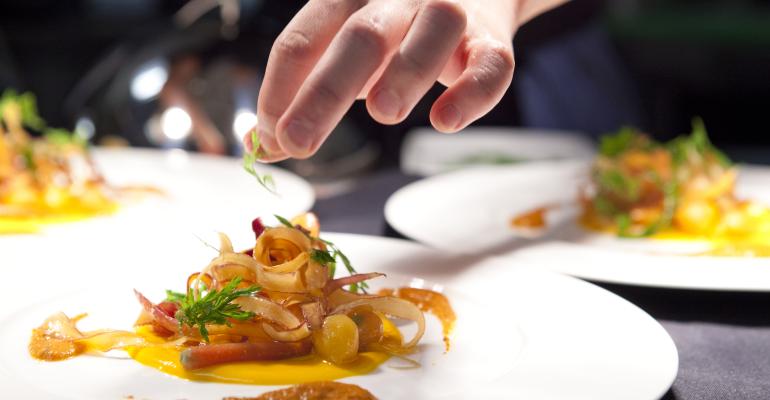Whether you are visiting a beloved neighborhood eatery for its hearty comfort food or celebrating a special evening at an upscale restaurant to discover the latest creations from an award-winning chef, the menu is central to a restaurant’s identity and to the guest experience.
Few areas of a restaurant’s operations require as careful deliberation as the menu. Factors include cost, product availability, prep time, training needs, and equipment requirements. While guests have come to expect specials and seasonal rotations on restaurant menus, I always advise clients to approach menu changes thoughtfully, and to engage as many members of the team in the process as possible. While owners may make the final decision, the restaurant team at every level can contribute valuable insights. Servers have intimate knowledge of what guests are looking for. The cooks know the setups of their station and which dishes are apt to create strain or bottlenecks. To ensure that a new menu item deserves a regular spot, test it out as a special on a Thursday or Friday night for a few weeks and gauge its popularity. Then you’ll know if it’s worth investing the time and effort into making it an official option.
There are many considerations that should drive menu development and menu changes. Below are my top six recommendations for how to approach the process so that menus can be well executed by kitchen staff, connect with diners, and inspire them to come back.
- Identify current trends and find one that fits your concept. People gravitate toward trendy food items — think bison burgers, creative sushi rolls, or any dish with ramps. But before jumping on the latest trend, owners need to ask themselves if it fits in with their particular brand. If a restaurant’s draw is its dependable down-home food, guests are looking for familiar dishes and not experimental fads. A restaurant known for its innovation, on the other hand, can take more culinary risks. If you’re looking to incorporate a trendy ingredient but want to do it in a low-stakes manner, consider adding it as an appetizer, a salad, or infusing it into a specialty cocktail.
- When creating new recipes, consider ingredients, cost, and regional favorites. If the cost of a trendy ingredient, like bison, would make the dish too expensive for a particular restaurant’s clientele, it’s not a good choice. Fast-casual diners are looking for dependable, quality food at the best price point and will likely be put off by a $28 burger. An alternative to capitalizing on trends is finding ways to connect the menu to the local community or region. People traveling through states are likely to eat out, and they love to see a regional dish. These dishes give restaurants an opportunity to showcase local ingredients and their own twist on regional favorites while still remaining true to who they are.
- Choose products that you can procure consistently. Nothing is more disappointing to diners than being told a restaurant is out of a beloved menu item. Specialty and trendy items like ramps can be difficult to procure. Make sure you have a good understanding of an item’s availability before selecting an item for regular menu rotation.
- Pay attention to plate presentation. Waiting for a dish to arrive provides delicious anticipation. When the waiter sets the dish before the diner, you want the presentation of that dish to be a memorable moment. The more senses that are engaged, the more memorable the experience. With the right training, staff can ensure that plates look as good as they taste. And remember that presentation extends to how food is boxed and wrapped as well. Little personal touches go a long way in creating an elevated experience.
- Understand timing of food delivery. Not all dishes can withstand a long wait. Some are designed to be enjoyed within a minute or two of being plated, while other meals can be boxed and prepared for takeout. Make sure that you have a good awareness of how dishes will hold up and whether they are meant to be taken out. Even with growing guest expectations around takeout availability, it’s important to prioritize food quality.
- Don’t forget the importance of marketing. Your restaurant could serve the most exquisite dishes in the world, but if people don’t know about them, they won’t have the opportunity to try them. As you plan your menu, keep marketing top of mind. Will you hire a food photographer? How will the dishes be featured on the website? What will you call them? How can you play into trends and seasons with your dishes and generate excitement across various social platforms? A good marketing strategy helps to set expectations for new and existing guests — and allows you to deliver on, and exceed, those expectations when they come in for a meal.
While it can vary from restaurant to restaurant, a typical cadence for updating menus is three to four times per year. For many places, this follows a natural rhythm, adopting dishes to the flavors of the season. But staying true to one’s brand identity remains paramount. Guests are visiting your restaurant for the elements that make you unique. Determine what those are and build your menu accordingly.
AUTHOR BIO
Mark Moeller is founder and president of The Recipe of Success, a national restaurant consulting firm. For more information, visit recipeofsuccess.com.





